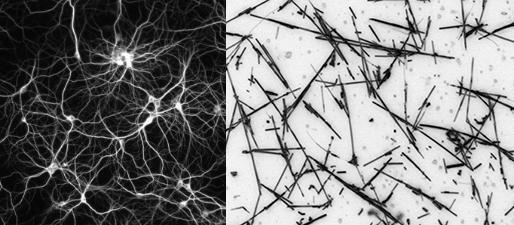Jun 30 2021
Researchers from the University of Sydney and the National Institute for Material Science (NIMS) in Japan have identified an artificial network of nanowires that can be adjusted to react in a brain-like manner upon electrical stimulation.
 An artist’s impression of a neural network (left) next to an optical micrograph of a physical nanowire network. Image Credit: Adrian Diaz-Alvarez/NIMS Japan (for nanowire image).
An artist’s impression of a neural network (left) next to an optical micrograph of a physical nanowire network. Image Credit: Adrian Diaz-Alvarez/NIMS Japan (for nanowire image).
The international research team, headed by Joel Hochstetter along with Professor Zdenka Kuncic and Professor Tomonobu Nakayama, observed that when the network of nanowires is maintained in a brain-like state “at the edge of chaos”, it carried out tasks at an optimal level.
According to the researchers, this indicates that the fundamental nature of neutral intelligence is physical, and this finding presents new, exciting opportunities for developing artificial intelligence.
The study was recently published in the Nature Communications journal.
We used wires 10 micrometres long and no thicker than 500 nanometres arranged randomly on a two-dimensional plane.
Joel Hochstetter, Study Lead Author and Doctoral Candidate, University of Sydney Nano Institute and School of Physics.
“Where the wires overlap, they form an electrochemical junction, like the synapses between neurons. We found that electrical signals put through this network automatically find the best route for transmitting information. And this architecture allows the network to 'remember' previous pathways through the system,” Hochstetter added.
On the Edge of Chaos
With the help of simulations, the team tested an arbitrary nanowire network to determine how to make it perform ideally to solve basic tasks.
If the signal mimicking the network was too weak, it means that the pathways were too orderly and predictable and failed to produce sufficient complex outputs that would be considered useful. However, if the network is overwhelmed by the electrical signals, the output will be fully chaotic and useless for problem-solving. The ideal signal for creating a useful output lies at the edge of this chaotic state.
Some theories in neuroscience suggest the human mind could operate at this edge of chaos, or what is called the critical state. Some neuroscientists think it is in this state where we achieve maximal brain performance.
Zdenka Kuncic, Professor, University of Sydney
Professor Kuncic is also the PhD adviser of Mr. Hochstetter and is presently a Fulbright Scholar at the University of California in Los Angeles, working at the intersection between artificial intelligence and nanoscience.
“What’s so exciting about this result is that it suggests that these types of nanowire networks can be tuned into regimes with diverse, brain-like collective dynamics, which can be leveraged to optimize information processing,” Professor Kuncic added.
Overcoming Computer Duality
Within the nanowire network, the junctions between the wires enable the system to integrate operations and memory into a single system. This is different from standard computers, which usually have separate operations (CPUs) and memory (RAM).
“These junctions act like computer transistors but with the additional property of remembering that signals have travelled that pathway before. As such, they are called 'memristors',” added Mr. Hochstetter.
This kind of memory takes a physical form in which the junctions at the intersecting points between nanowires serve like switches. This behavior depends on the switch's previous response to electrical signals. Upon applying signals across these junctions, very small silver filaments grow and activate the junctions by permitting the current to flow through.
“This creates a memory network within the random system of nanowires,” added Mr. Hochstetter.
Along with his team, Mr. Hochstetter had constructed a simulation of physical networks to demonstrate how they could be trained to solve very basic tasks.
“For this study, we trained the network to transform a simple waveform into more complex types of waveforms,” added Mr. Hochstetter.
In the simulation, the researchers tuned the frequency and amplitude of the electrical signal to observe where the optimal performance took place.
Mr. Hochstetter further added, “We found that if you push the signal too slowly the network just does the same thing over and over without learning and developing. If we pushed it too hard and fast, the network becomes erratic and unpredictable.”
The researchers from the University of Sydney are working closely with colleagues from the International Center for Materials Nanoarchictectonics at NIMS in Japan and UCLA where Professor Kuncic is also a visiting Fulbright Scholar.
The new nanowire systems were designed at NIMS and UCLA and Mr. Hochstetter devised the analysis, working with the study co-authors and fellow doctoral students, Ruomin Zhu and Alon Loeffler.
Reducing Energy Consumption
According to Professor Kuncic, the combination of memory and operations has huge practical benefits for the upcoming development of artificial intelligence.
Algorithms needed to train the network to know which junction should be accorded the appropriate 'load' or weight of information chew up a lot of power. The systems we are developing do away with the need for such algorithms.
Zdenka Kuncic, Professor, University of Sydney
“We just allow the network to develop its own weighting, meaning we only need to worry about signal in and signal out, a framework known as ‘reservoir computing’. The network weights are self-adaptive, potentially freeing up large amounts of energy,” added Professor Kuncic.
This implies that any upcoming artificial intelligence systems using these networks would have relatively lower energy footprints, concluded Professor Kuncic.
Journal Reference:
Hochstetter, J., et al. (2021) Avalanches and edge-of-chaos learning in neuromorphic nanowire networks. Nature Communications. doi.org/10.1038/s41467-021-24260-z.